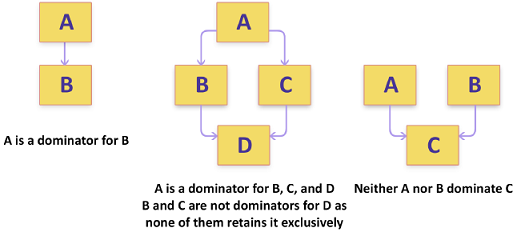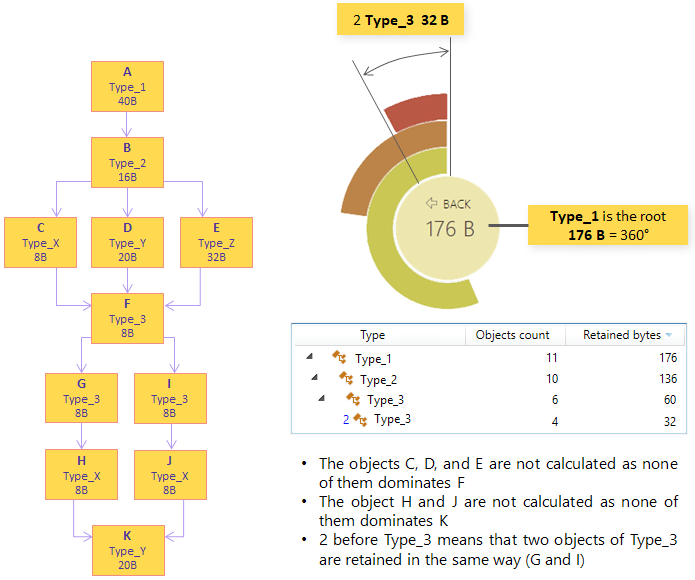Group by Dominators
The Group by Dominators view allows you to understand how memory is retained in your app. For example, you know that the major part of memory in your app is consumed by strings. Nevertheless, most likely, the subject of your optimizations are not these strings by themselves but data structures that store them. The Group by Dominators view answers the "Who retains the memory" question which is extremely important when analyzing ineffective memory usage. To answer this question properly, you should be acquainted with the concept of dominators.
What is a dominator?
The object A dominates the object B if every path to B from application's roots goes through A. In other words, the object B is retained in memory exclusively by the object A: If A is garbage collected, B is also garbage collected. For example, an array is a dominator for its elements (in case there are no other references to array elements). 
The Group by Dominators view consists of two parts:
- A tree list of dominators on the left.
- Sunburst chart on the right: a graphical representation of the tree list.
Dominators tree
The tree on the right shows the tree of dominators for the selected object set.
The tree can work in two modes that can be selected with the corresponding buttons in the tree header:
- Tree: All dominator nodes are shown. The dominators that take part in a domination path for the selected tree node are shown in bold.
- Path: Only the dominators that take part in a domination path for the selected tree node are shown.
The list of dominators consists of the following columns:
| Name | Description |
|---|---|
| Type | Type name. The number left to the type name shows how many objects of that type are retained that way. For example, elements of some array of integers A are retained in the exact same way (A -> element), but elements of an integer array B have another retention path (B -> element). |
| Retained Bytes | The overall size of exclusively retained objects in bytes. |
| Retained objects | The number of objects that are dominated by the dominator. |
Sunburst chart
Sunburst chart on the left is a graphical representation of the dominators tree. The more memory a dominator retains, the larger the central angle.
The analysis of the dominators tree can be quite complicated as you have to expand its nodes and interpret the numbers in the Retained bytes column. In contrast, just a glance at the sunburst chart allows you to determine main dominators and largest structures in your app. A click on a dominator you're interested in will show you its domination path in the tree.
Consider the example below for better understanding of how the sunburst chart displays data from the dominators tree.
Zooming in and Out
If you want to take a more detailed look at a certain dominator subtree, you can change the scale of the chart.
To zoom in on a dominator:
- Do one of the following:
- Double-click the corresponding arc in the chart or select Zoom in from its context menu.
- Double-click the dominator in the tree or select the tree and press Enter.
The dominator will become a root of the chart.
To zoom back out:
- Click the center of the chart.
Example

Selecting Objects for Further Analysis
In the Group by Dominators view, you can select the following subjects for further analysis:
- Objects retained by a particular dominator;
- Dominators.
- Objects exclusively retained (dominated) by the whole object set.
To open objects retained by a particular dominator:
- Do one of the following:
- Hold Alt and click the dominator in the tree or on the chart.
- Right-click the dominator and select Open objects retained via this domination path in the context menu.
After this, the Objects retained via [type_name] subject will be added to the Analysis Path and the list of desired objects will be displayed in the Group by Types view.
To open the dominator object set:
- Do one of the following:
- Hold Shift and click the dominator in the tree or on the chart.
- Right-click the dominator and select Open this object set in the context menu.
After this, the Dominators of [type_name] subject will be added to the Analysis Path and the list of desired objects will be displayed in the Group by Types view.
To select the objects that are exclusively retained by the analyzed objects set:
- Click the
 Open objects retained by this set button.
Open objects retained by this set button. After this, the Exclusively retained objects subject will be added to the Analysis Path and the list of desired objects will be displayed in the Group by Types view.